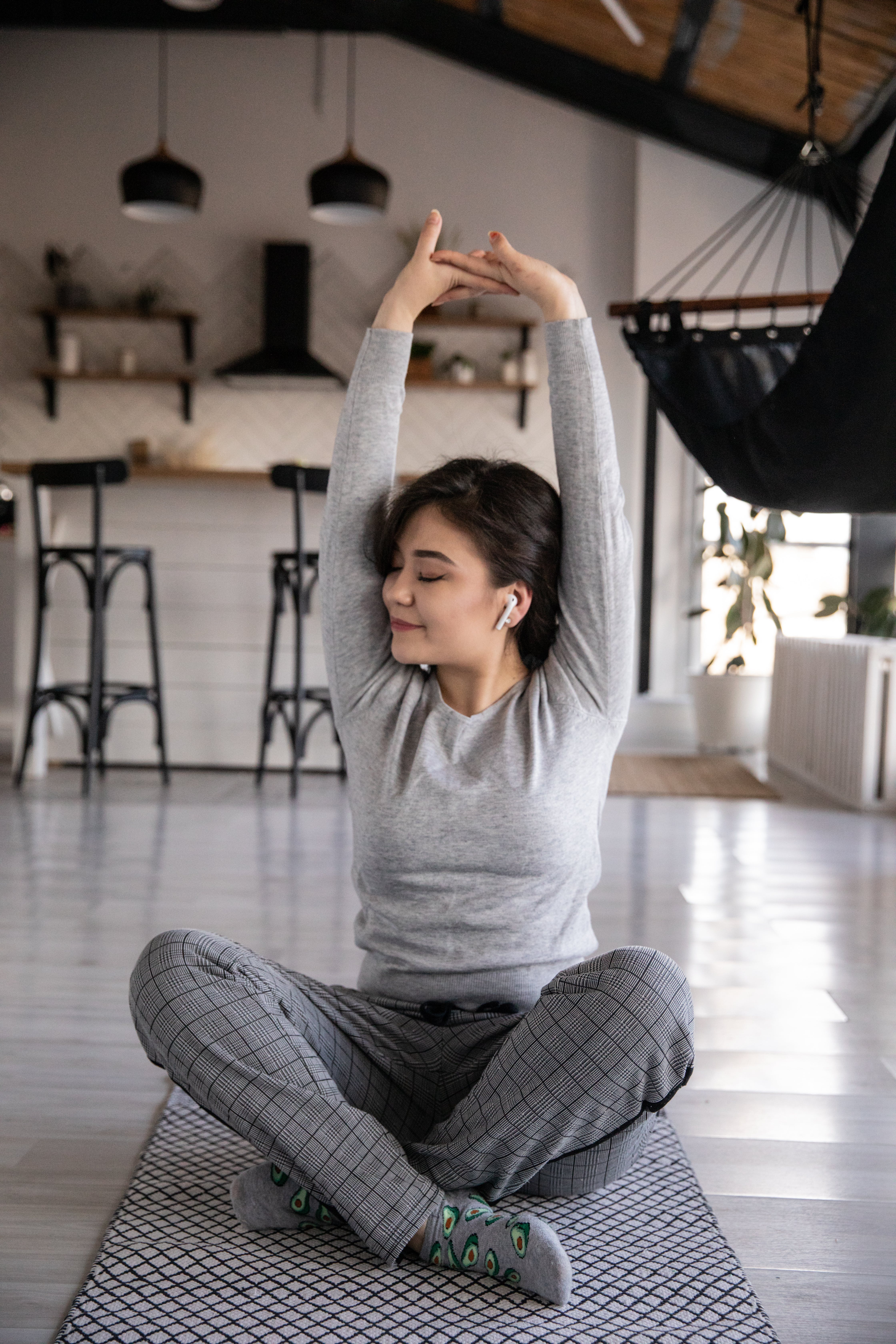Yoga clothing has become a big part of the fashion and lifestyle industries. It’s worth talking about because it’s sometimes the first thing people think about when they think about yoga. It can even put some individuals off starting yoga or attending group classes, due to feeling self-conscious about how they look in their yoga clothes.
Yoga clothing was a $30 billion industry in 2022 and is expected to grow to over $53 billion over the next ten years. Evidently, fashion retailers have a lot to gain from making people feel like they need to wear certain clothes and use branded accessories to do yoga. Out with the old, in with the new.
This is probably why the fashion industry is responsible for up to 10% of global CO2 emissions. From the amount of water mass producers use to make a single cotton T-shirt to the amount of “last-year’s fashion” pieces that end up in landfills, the industry has a lot to answer for.
And we certainly don’t want to contribute to the waste and skewed body perception it generates.
But that doesn’t mean you must do yoga in the nude. There are comfortable and eco-friendly options!
Be Comfortable, Be Sustainable.
You don’t need to wear specific clothes to do yoga.
The best thing to wear to yoga is clothing that feels comfortable and doesn’t get in the way of your practice. Ideally, it’s also clothing that doesn’t add to the pollution on the part of the fashion industry – so it’s also sustainable. Note that this doesn’t necessarily mean eco-friendly production – upcycling old clothes or buying at second-hand shops works, too!
Fashion trends, elitism, and a societal over-emphasis on body image can also be obstacles between yogis and mindful yoga sessions. Yoga should be about elevating your awareness of your body, not awareness of brands.
So, let us help you find the right clothes for yoga: clothes that are comfortable and sustainable. You’ll discover that the best clothes for yoga may already be hiding within your existing wardrobe, which is convenient for you and excellent for the planet. Then, we’ll look at the comfort and practicality of your yoga clothing in the following terms:
- Breathability
- Chafing
- Support
- Coverage
- How it makes you feel
The Best Thing to Wear to Yoga: Material
It’s not just the fashion industry – the yoga industry is a major contributor to plastic pollution worldwide, through clothing, mats, and packaging.

Clothing made from synthetic fibers:
- Requires a lot more energy to produce than clothing from natural fibers
- Releases more CO2 than natural fiber processing
- May have undergone intensive chemical processes that risk environmental contamination
- Can release potentially toxic microplastics
Therefore, the best thing to wear to yoga is something you already own. If you do want new clothes, however, upcycle second-hand clothes or use eco-friendly sources in the knowledge that even eco-friendly options are not perfect due to:
- The challenges of deforestation
- Inconsistent recycling and donation processes
- Pollution from microfibers (albeit less than from store-bought clothing and less damaging than from synthetic fibers), and
- Inconsistent efforts to mitigate chemical processing.
Having said all that, here are clothing materials to consider wearing for yoga in order to minimize the impact on the environment:
- Bamboo
- Ethically produced wool
- Hemp
- Organic cotton
- Organic linen
- Recycled cotton
- Recycled synthetics
- Silk
- Tencel branded Lyocell
The Best Thing to Wear for Yoga: Comfort
As well as being kind to the planet, the clothes you wear to yoga should be your friend. They should be comfortable without distracting you from your yoga practice.
Ideally, you won’t feel the need to adjust your clothing for modesty or comfort during or between poses. An adjustment now and then is realistic, but the goal is to focus on your body and mind, not wonder whether your underwear is showing.
The most effective clothing for yoga, therefore, is form-fitting clothing and something like sportswear that maintains its shape — or rather, adapts to your shape — as you move.
You might consider avoiding a very loose shirt, even though it may feel comfortable, in favor of tighter clothing that moves with you and doesn’t ride up or fall down during poses.
Consider:
- A sports bra
- A yoga top
- Yoga pants or leggings — the terms are often used interchangeably
- A jacket or sweater to keep you warm after your session, especially if you have to leave a building to go home.
- People typically do yoga barefoot, but if you want to wear socks, seek sports socks that can handle some moisture. Yoga socks also exist; they have grips underneath to help you maintain grip on your yoga mat.

The Criteria for Material & Comfort
Here’s a look at each element of your yoga clothing in more detail.
1. Breathability
How breathable the material needs to be depends on the type of yoga you’re doing.
You probably won’t break a sweat if you’re doing restorative or yin yoga. If you’re doing hot yoga, power yoga, or hatha yoga, however, breathable fabrics or moisture-wicking materials are recommended because you don’t want sweat cooling against your skin during cool down or when you leave a yoga studio.
Cotton is light, soft, and breathable, but it does hold moisture. People often wear sportswear for more energetic types of yoga as they incorporate breathability in their designs. However, as discussed, it’s important to consider the comfort and practicality of your yoga wear without losing sight of how you can support sustainable practices and minimize your contribution to environmental pollution.
2. Chafing
During yoga, the material of your clothing can move against your skin causing irritation or soreness.
When lunging, bending, and stretching, tighter clothing reduces friction and prevents chafing.
Women often dispense with a yoga top entirely if a sports bra provides adequate protection, support, flexibility, and coverage.
3. Support
Form-fitting clothing provides support for your body while you transition between and hold yoga poses. They also need to be stretchy or loose enough to move with you as you stretch and bend your body.
There’s not much room for a handstand in most fitting rooms, but do try to test your yoga gear before you leave the store.
Whether you’re purchasing gear or trying something from your existing wardrobe, experiment with a gentle lunge or forward bend.
Is your clothing supporting you or pinching you?
Look out for potentially uncomfortable seams and ask yourself if this clothing could support all parts of your body comfortably through an hour of sitting and standing, bending, twisting, and stretching.
4. Coverage
For the best coverage, many yoga practitioners like clothes that fit close to the body.
A sports bra or yoga top needs to be supportive enough that you don’t have to think twice about your wardrobe during standing forward bends or learning how to nail the handstand.
You may like yoga pants best when they grip the ankle or calf so that they don’t ride up during poses. Note that your pants or leggings need to handle friction from your yoga mat, your arms, and hands, so they need to be durable and well-behaved.
High-waisted yoga pants can help keep you covered during forward bends so that you can keep your mind on your posture rather than the not-so-secret life of wandering clothing.
Fortunately, there is a massive range of eco-friendly yoga pants for you to explore and enjoy.
How Your Yoga Gear Makes You Feel
Natural fibers feel way nicer on your skin than synthetic materials. Try them and feel the difference!
And remember that comfort is not only physical.

If you feel less anxious wearing baggy sweatpants and a hoodie, go ahead and wear them.
If the thought of getting into special yoga clothes means that you would skip yoga that day, wear whatever makes you feel comfortable.
If you’re doing a morning online yoga class, you can practice yoga in your sleepwear.
If you’re pregnant, don’t feel the need to stretch spandex over your bump. Whatever shape you are, wear clothes that make you feel comfortable and supported.
If you have a ten-minute break and you’re wearing a suit, do yoga in a suit.
If you feel cold, put on a sweater.
The Last Word on What to Wear to Yoga
The clothes you wear during yoga will depend on the kind of yoga you do.
Snug, form-fitting, breathable clothes stay out of your way, keep you dry, and support your body, whatever your yoga style.
Remember, however, that yogic philosophy includes deepening your connection with the natural environment. So it’s ironic that the fashion industry encourages us to wear yoga clothes that stamp all over the natural world.
You can counter this by being mindful of the impact your clothing choices have on the ecosystem and then making decisions that feel comfortable to you.
Finally, if wearing “the right clothes” – like form-fitting garments – threatens to come between you and your yoga practice, wear whatever makes you comfortable, supports your values, and puts a smile on your face.



Comments
Existing Comments